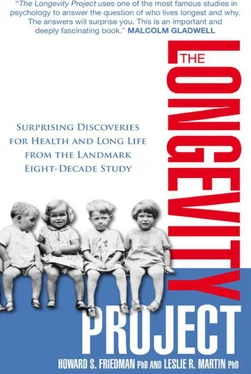Oversimplified recommendations may have made things worse. A while back, fear of fat emerged, as various well-meaning experts proclaimed the consumption of fat to be the big health hobgoblin. All sorts of low-fat foods were produced and marketed. Many people increased their carbohydrate intake instead. But fat and carbohydrate metabolism in the body is complicated, and it is not at all clear that a high-carbohydrate diet is healthy as a replacement. We are not sure of all the causes, but during the years since the health advisers began preaching against eating too much fat, the levels of obesity among Americans have increased dramatically.
Many other examples could be given of where “do this” or “don’t do that” recommendations are overly simple checklists that later turn out to be too narrow, misleading, or deadly wrong. Even when the recommendations are well-founded, lists of recommendations often fail to have their intended effect. If you make a typical list of New Year’s resolutions and head out on your own, you are highly unlikely to keep them over the long term.
When Lewis Terman began planning his major study back in 1919, American women could not vote, had limited property rights, and were excluded from many colleges. Most men and most women did not believe that women were or could be intellectual leaders equal to men, and neither did Terman. Yet to his credit, Terman included girls in his study.
African Americans, Latinos, Asian Americans, and others were often segregated into separate but unequal schools during this era, and likewise faced limited opportunities for college and advanced study. Dr. Terman made few if any efforts to find and include segregated minority groups in his studies. He was by no means a liberal-minded scholar, except in one key respect: He was enamored of data and he generally did not let his preconceptions bias the information on the 1,528 participants. He was careful in his data analyses. He documented both successes and failures. As times changed and his studies revealed certain conclusions, Terman changed his views. Although some scientists set out to use intelligence tests and achievement outcomes simply to further their preconceived political views, Dr. Terman generally presented loads and loads of facts.
The Mental-Physical Health Connection
Most societies allocate certain budgets of money and resources to strengthen the social fabric, economic potential, and mental health of their citizens—programs for education, to prevent drug abuse, to help families, to provide parks, and to offer job training and other programs to lift people out of poverty. Different pots of money and resources are allocated to health care, to train doctors, build hospitals, research disease, and provide health insurance or access to care. The implicit view is that most individuals will naturally stay healthy, but if by chance they get sick, then well-trained physicians should be available to treat them.
Our many years of study of the Terman participants have led us to a different conclusion. Our studies suggest that a society with more conscientious and goal-oriented citizens, well integrated into their communities, is likely to be a society of health and long life. Of course, this will be especially helpful if the community also has clean and safe air, water, and food, and good schools and safe streets; but few appreciate the extent to which mental health is the close companion of physical health. And few fully grasp the importance of helping to develop the social patterns that let each individual find an appropriate way forward, step by step.
A parallel set of conclusions has been reached by neuroscientists studying stress early in life. For example, researchers at Rockefeller University argue that biological disruptions early in life set forces in motion that appear as disease decades later. 102 102 To read more from the Rockefeller researchers, see J. P. Shonkoff, W. T. Boyce, and B. S. McEwen, “Neuroscience, Molecular Biology, and the Childhood Roots of Health Disparities: Building a New Framework for Health Promotion and Disease Prevention,” Journal of the American Medical Association 301 (2009): 2252-59.
It is too soon to know for sure how much of the health risk becomes embedded early on in our biological systems and how much depends on the subsequent psychological and social processes that occur throughout life. But the implications are similar: well-adjusted children growing up in a socially stable society are much more likely to become healthy, long-living adults.
When in September 1921, the talented, conscientious young schoolgirl named Patricia was pulled out of her San Francisco classroom to be tested by Dr. Terman, neither she nor her teacher nor Lewis Terman knew much about what paths would enable her and some of her classmates to live in good health for more than nine decades. Dr. Terman rarely mentioned the word longevity , but in 1947, with the study near its halfway point, he wrote, “it is still too early to estimate accurately the ultimate contribution of the group to science, scholarship, literature, and social welfare, or its ultimate fertility, longevity, insanity rate, and divorce incidence.” 103 103 The Terman quote mentioning longevity comes from Terman and Oden, Genetic Studies of Genius , vol. 4, The Gifted Child Grows Up , 379.
It’s not too early anymore. We hope the guideposts on the path to long life illuminated by the Terman subjects will inspire changes in our social and health care systems that will help us all travel healthier passages. Our own future work will focus on the development and implementation of such policies.
Any significant scientific project in the health field involves a large number of colleagues and assistants, and we are truly grateful to those who helped us in our efforts. The major scientific collaborators in our various research studies are listed below in the section entitled “Research Collaborators.” In addition, the coauthors and grant support of our relevant scientific research papers are listed in the references in the endnotes. Many other talented graduate students, undergraduate students, and other faculty colleagues also played a valuable research role in many of our studies. Our twenty-year research project built directly upon the eight-decade study Lewis Terman launched—and all the many dozens of contributors deserve thanks but cannot be individually named here.
Regarding the preparation of this book, we greatly appreciate the editorial suggestions made by our friends and associates, including Carlin Flora, Jhoshua Friedman, Joel Haldeman, Dr. Karen Shaw, Dr. Miriam Schustack, Rebecca Shiffman, and Michael Tyler. Eli Friedman provided advanced computer expertise. We thank our professional colleagues and support staff at the University of California, Riverside, and La Sierra University, especially Michael Yonezawa for expert library assistance and Mrs. Dianne Fewkes for research administrative support.
Our literary agent, Barbara Lowenstein, devoted her formidable expertise to this project. Finally, we thank the people at Hudson Street Press, especially Caroline Sutton, who had a clear vision for the direction of this book, and Anna Sternoff, who was heroically devoted to editing the myriad findings and conclusions and getting all the details just right.
The findings reported in this book are based on twenty years of investigation by our research team, as well as our refinement and supplementation of over eight decades of data on the Terman participants. The following collaborators played a significant role in one or more of the studies. The interpretations and conclusions in this book are our own and have not been checked or endorsed by our research collaborators. Relevant research papers are referenced in the endnotes. Any opinions or errors herein are ours and not the responsibility of any research collaborator.
Читать дальше











